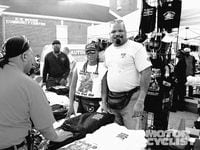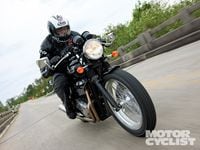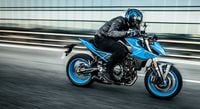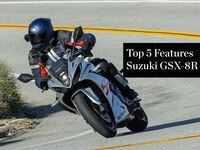I'm riding along Franklin Road, an undulating ribbon of Western Pennsylvania tarmac with more twists than a John le Carre spy novel. Heavily residential in places, it's perfect for medium-speed, big-lean cornering, provided you don't get on the throttle too hard. Naturally, some of the sportbike riders who frequent the area do just that, and I encounter a Suzuki Hayabusa pilot in a particularly tight, decreasing-radius turn. Just as I realize he's edging toward the centerline, he whips one hand off the clip-ons and issues me an elaborate, biker-friendly salute.
Say what?
I wish I was shocked by this random act of stupidity, but motorcyclists waving at each other at inopportune moments is one of the sport's most enduring annoyances. It ranks right up there on my pet-peeve list with helmetless riders dressed as though they're entered in the MTV Rock and Jock Beach Volleyball Tournament. But while the flip-flops-and-wife-beater crowd can be dismissed as squids who will soon be riding hospital gurneys instead of motorcycles, the wavers should know better.
I've observed this dated ritual evolve over the past three decades, and I'm puzzled by its persistence. Back in the 1970s, it was only grizzled outlaw bikers-or those who emulated them-who issued fist-clenched salutes when encountering other bikers on the roads. They were selective in their greetings, waving only at fellow Harley-Davidson pilots, creating a sense of social abandonment for folks riding foreign-made motorcycles. Fast-forward a few years and the Harley crowd became friendlier, with waves exchanged among riders of all stripes. Lately I've been waved at by senior citizens tootling along on mopeds and scooters, as well as contestants in the Sonny Barger Dress-Alike Contest. Flattered? Sure. But I doubt most of these riders would pull over to help if my bike broke down or got a flat, which a half-century ago was part of what waving at each other was all about. Back when motorcycles were scarce on American roads, a friendly wave suggested, "Hi, friend. If something goes wrong, I've got your back." Today, it's more like "Hey, I bought a bike, so I'm as cool as you, right?"
Personally, I've always felt the overt display of kinship between people who've never actually met is big-time phony. It reminds me of the fake air-kisses exchanged by Upper East Side socialites, or the choreographed, nine-part, dap-slap handshakes of the inner city, which have more to do with self-perpetuating mystique and the exclusion of outsiders than any sort of group camaraderie. And at its worst, waving makes motorcyclists feel it's more important to initiate some arcane, insider's secret greeting than to worry about more pressing matters-like that 19-year-old who's busy texting his friends about the new Blink 182 record when he should be trying not to run you over.
The showy, self-serving and theatrical side of the wave revealed itself to me recently during a test ride in the countryside surrounding Berlin. Several American journalists were riding at the head of the pack, and one couldn't resist waving at every motorcycle that approached from the opposite direction. This was in Germany, after all, where motorcycles are used as daily transportation and are as common as pilsner and pretzels in pubs. At a rest stop, the wave-happy American lamented the lack of return-waves, and wondered aloud why no one responded to his raised hand. One of the German tour guides overheard him and offered a piece of advice that's sound on either side of the Atlantic. "Nobody waves here because we're concentrating on proficient riding," he said in a Schwarzenegger-like accent. "The time to make friends is after the ride."


/cloudfront-us-east-1.images.arcpublishing.com/octane/7OWQWAWJBFCGTAYQWBMWGNMNB4.jpg)
/cloudfront-us-east-1.images.arcpublishing.com/octane/4G5XKCDIHRCGRHVF7OPORG7ZX4.jpg)
/cloudfront-us-east-1.images.arcpublishing.com/octane/D2BDYKKNZ5GRHGDMI4PZTGRMME.jpg)

/cloudfront-us-east-1.images.arcpublishing.com/octane/UAY4WSZPOFDQRP4MCEXAKDFQOQ.jpg)

/cloudfront-us-east-1.images.arcpublishing.com/octane/X5CE3KSJHZHM5CUFGPZ7U26WB4.jpg)
/cloudfront-us-east-1.images.arcpublishing.com/octane/COWLTPGFAFGDDGJCTENYMA4VJM.jpg)
/cloudfront-us-east-1.images.arcpublishing.com/octane/H3PKUGPSUJFTND4RFPSI4OIDCE.jpg)
/cloudfront-us-east-1.images.arcpublishing.com/octane/UHGQA3MQDFCA3HLBWF7S76WH6Y.jpg)
/cloudfront-us-east-1.images.arcpublishing.com/octane/Q5EORCSTNFAVBJC4IYUHIKJTXQ.jpg)
/cloudfront-us-east-1.images.arcpublishing.com/octane/XIJ5FUFSP5A3NL7MOVZGJXAHC4.jpg)
/cloudfront-us-east-1.images.arcpublishing.com/octane/V5NZN3CGS5B5PPYFYJHIPAU5S4.jpg)
/cloudfront-us-east-1.images.arcpublishing.com/octane/CZE6ONOBU5E7HPIEEADU376C4M.jpg)
/cloudfront-us-east-1.images.arcpublishing.com/octane/UT4KL3SIYJBSPNHWJXTBE6MTGE.jpg)
/cloudfront-us-east-1.images.arcpublishing.com/octane/Q3UOIDZ22ZEVDBZUWGJXIMGJKI.jpg)
/cloudfront-us-east-1.images.arcpublishing.com/octane/YQM66WXZV5AAXNNOIUVOGVXZMY.jpg)
/cloudfront-us-east-1.images.arcpublishing.com/octane/J47NFTXNLFFGHELHZCUD2LCITA.jpg)
/cloudfront-us-east-1.images.arcpublishing.com/octane/NXPQBTLX3NCILKQ2GCFJYNIDEM.jpg)
/cloudfront-us-east-1.images.arcpublishing.com/octane/6U7NJLAYMRBZTIGNKWIA5OK2FQ.jpg)
/cloudfront-us-east-1.images.arcpublishing.com/octane/IYTZQWUROVC25IMTDEWUDQ5IQE.jpg)
/cloudfront-us-east-1.images.arcpublishing.com/octane/YJODDXEL2ZB5TENKPPN4BEYJAE.jpg)
/cloudfront-us-east-1.images.arcpublishing.com/octane/QEQQUZYNJFAIJB4DZFVFSNTCQ4.jpg)
/cloudfront-us-east-1.images.arcpublishing.com/octane/F4EEHDT3UZFKPLKVGDWMMPFEQE.jpg)